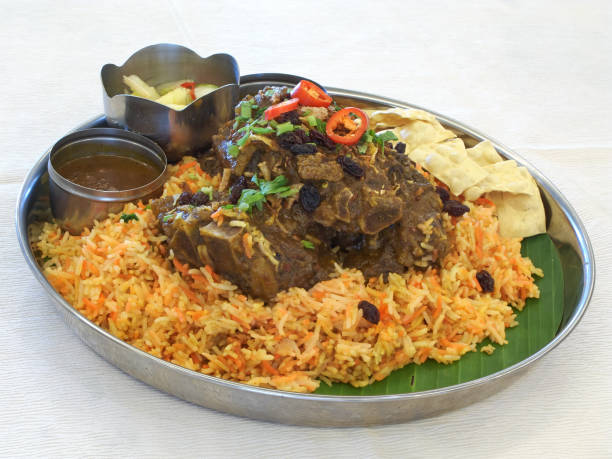Imagine hosting a feast, the centerpiece being a fragrant pot of mutton biryani. The steam escapes as you lift the lid, filling the air with the tantalizing aroma of spices and perfectly cooked mutton. Guests eagerly serve themselves, only to find the meat tough and unyielding. This is every biryani enthusiast’s nightmare. The secret to a show-stopping mutton biryani lies in achieving tender, flavorful meat that melts in your mouth. But how do you ensure this every time? Read on to uncover the secrets of crafting a mutton biryani that will leave everyone asking for seconds.
The Significance of Tender Mutton in Biryani
Mutton biryani is more than just a dish; it’s an experience that brings together the richness of tender meat, aromatic spices, and fluffy basmati rice. Tender mutton absorbs the spices beautifully and complements the texture of the rice, creating a harmonious blend of flavors. Tough meat, on the other hand, disrupts the entire experience, making it crucial to get this element just right.
Choosing the Right Cut of Mutton
When it comes to cooking mutton, selecting the right cut can make all the difference in the flavor, tenderness, and overall quality of the dish. With so many cuts to choose from, it can be overwhelming for home cooks to decide which one to use. In this guide, we’ll break down the different cuts of mutton, their characteristics, and the best ways to cook them, making it easier for you to choose the perfect cut for your next recipe.
Understanding Mutton Cuts
Mutton cuts can be broadly classified into three categories: primal cuts, sub-primals, and retail cuts. Primal cuts refer to the initial cuts made on the carcass, such as the leg, loin, and shoulder. Sub-primals are smaller cuts made from the primal cuts, while retail cuts are the final cuts sold to consumers.
Popular Mutton Cuts
Leg of Mutton
A classic cut, perfect for slow-cooking methods like braising or stewing. The leg is tender, and flavorful, and falls off the bone when cooked.
Rack of Mutton
A tender and lean cut, ideal for roasting or grilling. The rack is made up of 6-8 ribs and is perfect for special occasions.
Shoulder of Mutton
A flavorful and tender cut, great for slow-cooking methods like stewing or braising. The shoulder is perfect for hearty, comforting dishes.
Mutton Chops
Thick and juicy, mutton chops are perfect for grilling or pan-frying. They’re a great option for a quick and flavorful meal.
Mutton Shanks
A tougher cut, perfect for slow-cooking methods like braising or stewing. Mutton shanks are flavorful and tender, making them a great option for comfort food.
Tips for Choosing the Right Cut
Consider the cooking method Different cuts are suited to different cooking methods. For example, tougher cuts like shanks are perfect for slow-cooking, while tender cuts like racks are better suited to roasting or grilling.
Think about the flavor profile Mutton can be quite strong, so it’s essential to choose a cut that suits your flavor preferences. For example, if you prefer a milder flavor, opt for a cut like the rack or chops.
Look for marbling Marbling refers to the streaks of fat that run through the meat. Cuts with good marbling tend to be more tender and flavorful.
Ask your butcher If you’re unsure about which cut to choose, ask your butcher for advice. They can help you select the perfect cut based on your cooking method, flavor preferences, and budget.
The foundation of tender mutton starts with the right cut. Not all cuts of mutton are suitable for biryani. Here are some guidelines:
Bone-In Cuts
Bone-in cuts, such as shoulder or leg pieces, are ideal for biryani. The bones add richness and flavor to the dish while ensuring the meat stays moist.
Freshness Matters
Always choose fresh, pinkish-red mutton with a firm texture. Avoid meat that appears pale or has a strong odor, as this indicates poor quality.
Fat Content
A moderate amount of fat enhances the flavor and helps keep the meat tender during cooking. Cuts with a marbling of fat are perfect for biryani.
The Art of Marination
Marination is the first step to ensuring tender mutton. It not only infuses flavor but also helps break down the proteins in the meat, making it softer. Follow these tips for the perfect marination:
Ingredients for Marination
Yogurt: The natural acids in yogurt act as a tenderizer and help the spices penetrate the meat.
Lemon Juice: Enhances the tenderizing effect while adding a slight tang.
Ginger-Garlic Paste: Adds depth of flavor and aids in breaking down the meat fibers.
Spices: Use turmeric, red chili powder, garam masala, and cumin for a flavor-packed marinade.
Duration of Marination
For the best results, marinate the mutton for at least 4-6 hours. If possible, leave it overnight in the refrigerator. This extended marination time allows the acids and spices to work their magic.
Marinating Tips
- Use a non-reactive bowl (glass or stainless steel) to prevent the acids from reacting with the container.
- Cover the bowl with cling wrap or a lid to prevent the marinade from drying out.
Cooking Techniques for Tender Mutton
Cooking the mutton properly is just as important as marinating it. Here’s how to ensure it turns out perfectly tender:
Slow Cooking
Mutton becomes tender and flavorful when cooked slowly. Use a heavy-bottomed pot and cook on low heat to allow the meat to break down gradually.
Pressure Cooking
If you’re short on time, a pressure cooker can be a lifesaver. Cook the mutton with a little water and whole spices for 2-3 whistles. Ensure you don’t overcook it, as the meat will continue to cook during the dum process.
Avoid Overcrowding
Cook the mutton in batches if necessary to avoid overcrowding the pot. This ensures even cooking and prevents the meat from steaming instead of searing.
Add Salt at the Right Time
Add salt towards the end of cooking to prevent drawing out too much moisture from the meat early on, which can make it tough.
Layering for Perfect Biryani
The layering process plays a significant role in the outcome of your biryani. Here’s how to do it right:
First Layer: Cooked Mutton
Place the cooked mutton at the bottom of the pot to allow its juices to permeate the rice.
Second Layer: Par-Cooked Rice
Add partially cooked basmati rice over the mutton. This ensures the rice absorbs the flavors of the meat and spices during dum cooking.
Final Touches
Sprinkle fried onions, saffron milk, fresh mint, and ghee between layers. These elements enhance the aroma and richness of the biryani.
The Dum Cooking Method
Dum cooking, or slow steaming, is the traditional method for finishing biryani. It helps the flavors meld together while ensuring the meat remains tender. Here’s how to master dum cooking:
Sealing the Pot
Seal the lid with dough or foil to trap the steam. This ensures even cooking and prevents moisture from escaping.
Heat Control
Start with high heat for 10 minutes to generate steam, then reduce to low heat for 30-40 minutes. Use a tawa (griddle) under the pot to distribute the heat evenly.
Resting Time
Let the biryani rest for 10 minutes after cooking before serving. This allows the flavors to settle and enhances the overall taste.
Common Mistakes to Avoid
Skipping Marination: Results in bland, tough meat.
Overcooking: Makes the meat dry and stringy.
Insufficient Resting Time: Prevents flavors from fully developing.
Using Low-Quality Meat: Compromises both flavor and texture.
Serving Suggestions
Pair your mutton biryani with these accompaniments for a complete meal:
- Raita: A cooling yogurt-based side dish with cucumber and mint.
- Salad: A simple onion and tomato salad with a dash of lemon juice.
- Pickles: Adds a spicy kick to complement the richness of the biryani.


